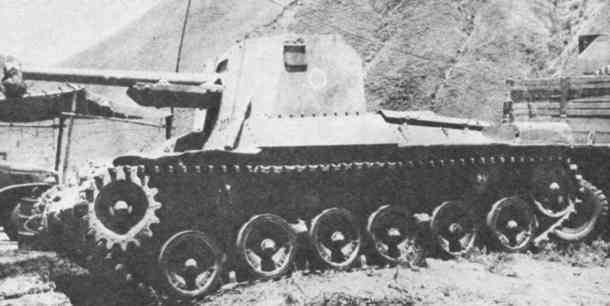Type Tank destroyer Produced 1942 Length 5.9 m (19 ft 4 in) | Weight 15.4 tons | |
 | ||
No. built 26 of Type I and 54 of Type II | ||
The Type 1 Gun tank Ho-Ni I (一式砲戦車 ホニ I, Isshiki ho-sensha Ho-Ni I) was a tank destroyer developed by the Imperial Japanese Army for use during World War II in the Pacific theater.
Contents
History and development
The Type 1 Ho-Ni I was the first self-propelled gun design of this particular type. They were meant to be self-propelled artillery and tank destroyers for armored divisions.
The Type 1 Ho-Ni I was developed by using the existing Type 97 chassis and engine, and replacing the gun turret with a 75 mm Type 90 Field Gun mounted in an open casemate with frontal and side armour only. The gun mounting gave ten degrees of traverse and -5 to +25 degrees of elevation; it could also traverse 20 degrees to either side, so the entire vehicle did not have to be turned. The Type 1 Ho-Ni I carried 54 rounds of ammunition.
They were designed to operate as self-propelled artillery at ranges of up to 12,000 metres (7.5 mi). The design had no provision for a defensive machine gun, which together with the open structure made it vulnerable in close combat.
The Type 97 chassis, suspension and diesel engine were used unchanged. The 75 mm Type 90 Field Gun, was protected on three sides by 51 mm thick armored plate. The hull armored plate was 25 mm on the sides and 20 mm on the rear.
Variants
The Type 1 Ho-Ni II was one variant. It mounted a Type 91 105 mm howitzer and had a slightly changed superstructure as far as the side armor with re-positioned observation visors. A total of 54 units were built. The other variant was the Type 3 Ho-Ni III which mounted a Type 3 75 mm tank gun in a completely enclosed superstructure.
Service history
The Type 1 Ho-Ni I was first deployed in combat at the Battle of Luzon in the Philippines in 1944, with limited success, but it was not available in any numbers to make an impact on the Battle of the Philippines.
The Type 1 Ho-Ni I was produced in small quantities in 1942, when it was superseded by the Type 1 Ho-Ni II and then the Type 3 Ho-Ni III. The total number of the Ho-Ni series produced was 111 units. The total number of Type 1 Ho-Ni I units produced was only 26.
Most of the remaining Ho-Ni units were retained within the Japanese home islands to form part of the defenses against the projected American invasion, and did not see combat before the surrender of Japan.
Survivors
A Type 1 Ho-Ni I from the IJA 2nd Armored Division, 2nd Armored Artillery Regiment was captured by the US Army 37th Infantry Division on Luzon on April 6, 1945 as is currently at the United States Army Depot, Anniston, AL.
